Illnesses of the Hairless Cavy
Skinny pigs and Baldwin guinea pigs have much the same health as haired guinea pigs, with hairlessness being an honest, but not overwhelming, additional concern. The biggest difference between haired and hairless guinea pigs in terms of health seems to be that without extra hair to keep them warm and usually without as much body fat in reserve, hairless cavies, if sick, can crash much faster and be harder to recover than standard guinea pigs.
Please note, this information is not intended to be a substitute for professional medical advice, diagnosis, or treatment. Always seek the advice of your experienced cavy veterinarian or other qualified veterinarian with any questions you may have regarding your animal's medical condition. Never disregard professional medical advice or delay in seeking it because of something you have read on this website or elsewhere on the internet.
If you think you may have a medical emergency, call your veterinarian or go to an emergency veterinarian immediately. Santa Barbara Skinny Pigs and Erin Koski do not recommend or endorse any specific tests, veterinarians, products, procedures, opinions, or other information that may be mentioned on our website.
Scratches or Wounds Gastrointestinal Distress Ringworm URI (Upper Respiratory Infection) Bumblefoot Pregnancy Toxemia Malocclusion Allergies Scurvy Bacterial Skin Infection Parasites Bloat
Knowing Good Body Condition
On the plus side, you can see the body condition of a hairless guinea pig much more easily than you can if there is fur covering the body. Unfortunately, maybe in part due to the name "skinny pig", many people think that an underweight hairless guinea pig is healthy when it is not.
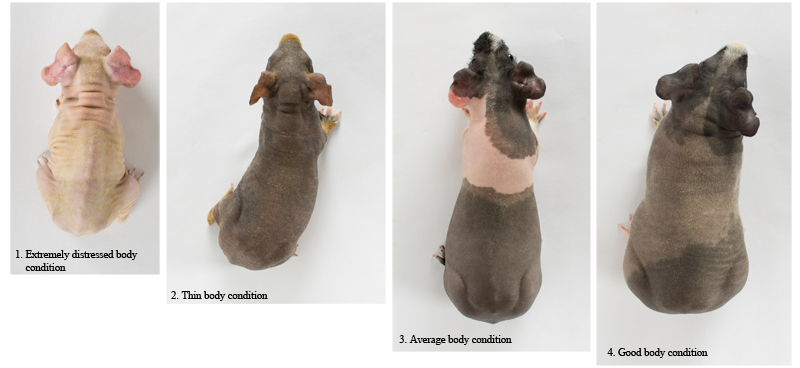
From left to right: 1. Extremely distressed body condition, 2. Thin body condition, 3. Average body condition, and 4. Good body condition (click the image to see in larger size). Photo copyright Erin Koski
A guinea pig with thin body condition (number 2 above) has no extra body fat and muscle tone is light, not full. This state should be treated with great concern and every effort should be made to treat any health problems and improve overall condition. The skinny pig in this condition will be less rounded than ideal and have some sharp features. Her spine may be showing slightly. In the picture above, compare the thin guinea pig to the average one (number 3). The average guinea pig has an obviously fuller neck and shoulders. The thin guinea pig also has visibly sunken areas around her eyes.
In an extreme situation (number 1 above), the spine is clearly visible through the skin, as are rib bones and leg bones. The area under and around the eyes appears hollow or sunken. This is an emergency situation and without immediate medical attention the guinea pig will probably die. The animal pictured above (number 1) was under veterinary care for a week due to a gastrointestinal issue, but did not improve. This photo was taken a few days before he passed away. The guinea pig in thin condition (number 2) also had a gastrointestinal issue but recovered her health.
A hairless guinea pig in good body condition (number 4 above) will have extra fat deposits around the neck and lightly across the shoulders. She will appear chunky and rounded, without sharp features. Her back will be broad and smooth.
Scratches or Wounds
Hairless guinea pigs are especially susceptible to being scratched or being more easily wounded in an altercation with another guinea pig or other animal, or from contact with a sharp edge in a cage, on a hide box or a toy. Superficial scratches or small wounds can be left alone to heal. Punctures, bites, or more serious wounds should be seen by an experienced cavy veterinarian and will need extra care to ensure they do not become infected.
Gastrointestinal Distress
All guinea pigs have fairly sensitive digestive systems, but for the reasons mentioned at the top of this article, it is particularly important to notice and treat any signs of digestive upset in your hairless cavy very quickly. Gastrointestinal issues can be caused by a number of factors but some of the most common triggers are sudden changes in food, water, hay or bedding. Sudden changes can have serious effects on the flora in their intestines, which can result in weight loss, dehydration/diarrhea, and sometimes even death. Any changes to food, water, hay or bedding should be made gradually, over a period of one to three weeks. When bringing a new guinea pig home, do what you can to obtain samples of these things from the previous home to make the change as smooth as possible.
The early signs of GI distress tend to be a loss of body condition. The reduction of body fat and/or muscle tone makes the cavy lose their soft, plump look and begin to appear sharper, with hints of spine or ribs almost visible. Their belly may become more round in appearance, and they may have a more hunched backed look when standing still. This is the best time to intervene. Pro-biotics can be given, and sweet or plain grains (rolled oats, wheat, barley, with or without a little molasses) can be mixed into their pellets to boost their calories and fat intake.
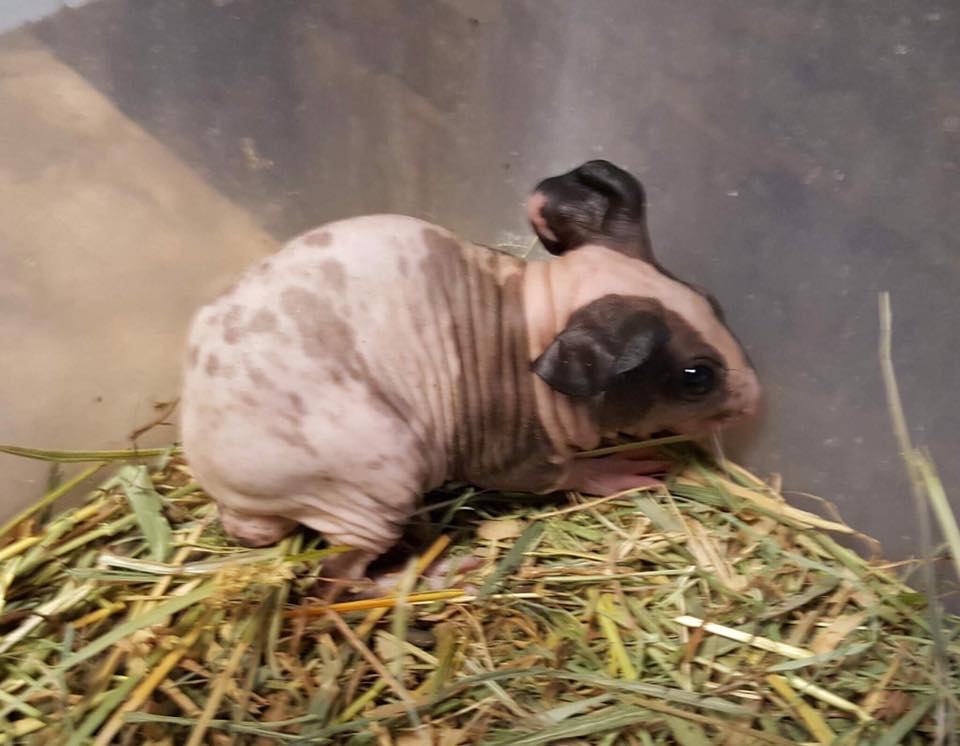
This young skinny pig may be in the very early stages of GI distress. Note the hunched appearance and lean body.
If no improvement occurs, if the guinea pig's condition worsens or if the issue is not noticed until symptoms are advanced, the animal should be taken to an experienced cavy veterinarian immediately. Advanced signs include severe deterioration in body condition, with ribs, spine and other bones clearly visible under the skin. Belly is often round and may look slightly bloated. Posture is usually very hunched and these cavies almost always have diarrhea. Wet or dry feces will be seen on their belly, feet and balled on their toe nails. Eyes may be sunken or have crusty build up.
Hairless guinea pigs in severe GI distress should also have extra warmth during their recovery. This should be safely provided using a heating pad, space heater, or heating lamp. Always use great care with external heat devices to ensure there is no danger of providing too much heat or causing burns. Cloth cozies, cubes or other heat-retaining houses or hides can also be used to help the sick cavy retain body heat.
Antibiotics
If your veterinarian prescribes antibiotics, make sure to also have probiotics on hand to administer 2-3 hours after the antibiotics. The antibiotics will not only affect the detrimental bacteria, but the good. It is not uncommon for a sick guinea pig to actually get worse once put on antibiotics as their good gut flora takes a hit along with the bad bacteria. Probiotics can usually be purchased at your local pet store, and come in a gel or powder form. They should be the products designed for mammals such as dogs, cats, horses, goats, cows or rodents. Do not use human products, yogurt, or probiotics designed for reptiles as these will not be effective.
Ringworm
Ringworm is a fungal skin infection that is highly contagious to other guinea pigs and also to people. Skinny pigs seem to be more susceptible to getting ringworm than some other varieties of guinea pigs, but treatment is generally simple and inexpensive. Ringworm typically expresses as a white, crusty or scaly patch on the surface of the skin. It may have a circular, oval or ring-like appearance, or may look similar to a crusty wound. On a light-skinned guinea pig, redness may occur at the site of infection. It is also common for a guinea pig with one spot of ringworm to develop several others, so a thorough inspection of all areas of the body is needed in order to find and treat the spots.
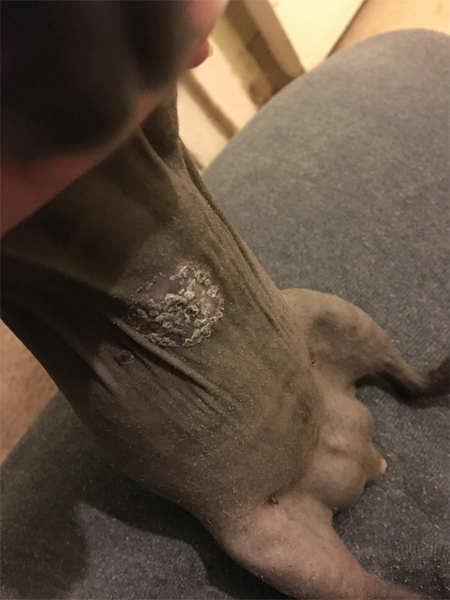
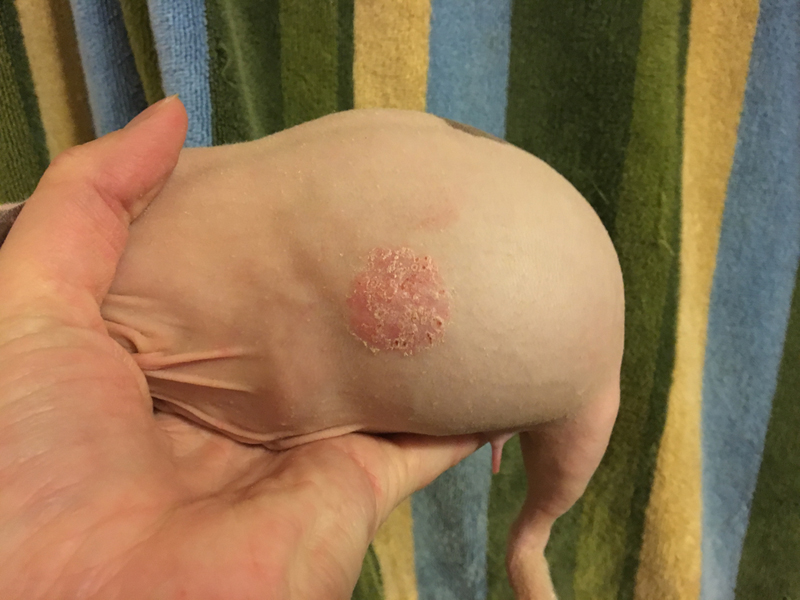
Pictures of large ringworm circles on both dark and light colored skinny pig skin. In this case, their owner was out of town for one week and the infection wasn't noticed immediately. This probably represents about one week of untreated growth.
Formal diagnosis should be made by an experienced cavy veterinarian. Treatment options include oral or topical medications and ringworm is typically cleared up in four to six weeks. In addition to treating the infected guinea pig, the guinea pig's cage, toys and accessories should be thoroughly sanitized during and after treatment. Sanitation of cages should be done using a mild bleach and water solution. Toys, food dishes and water bottles should be run through a dishwasher or washed with a bleach and water solution, as appropriate. Fleece, cloth and cozies should be put through a washing machine. Once in your guinea pig's house, ringworm is extremely hard to get rid of because it thrives in the conditions your guinea pig is always trying to make their cage - damp and poopy. Frequent cleaning, and cleaning with bleach, will reduce the chances of reinfection.
Since ringworm is contagious to people, you should wash your hands thoroughly after handling guinea pigs who are infected.
URI (Upper Respiratory Infection)
Guinea pigs have sensitive lungs and are highly susceptible to respiratory infections. This is the result of spending most all of their lives with their noses very close to the ground. Poor ventilation, dirty housing, ammonia build-up and excessive dust can all lead to URI in your guinea pigs.
Symptoms include wheezing, raspy breath, sneezing, coughing, and/or discharge around the nose.
Formal diagnosis should always be made by an experienced cavy veterinarian. If treatment is to include antibiotics, see our important notes on use of probiotcs above.
To reduce the risk of your guinea pigs coming down with URI, cages must be cleaned very frequently, to minimize any buildup of ammonia or feces. The cage should be located in an area with a good, stable temperature, but also good ventilation so the air does not become stale in the cage. Cages with solid walls such as aquariums, plastic storage tubs or solid-walled wooden cages should be avoided and cages with metal bars or grids should be used instead.
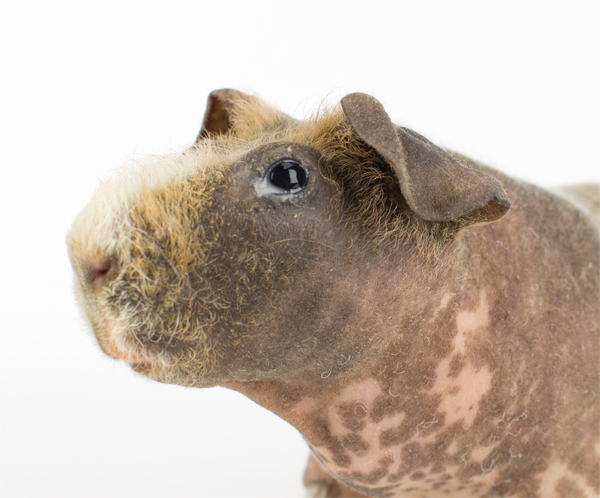
Excessive weeping from the eye and/or lots of eye crusties are often the first stymptom of an upper respiratory infection.
Bumblefoot (Pododermatitis)
Bumblefoot is an infection of the foot, resulting in redness, swelling, and/or sores. It may look small in size but should be taken very seriously as it can lead to loss of toes, a foot or even cause death in guinea pigs. Common causes include rough flooring, abrasion or wound of the foot and unsanitary cage conditions. Formal diagnosis should be made by an experienced cavy veterinarian. If treatment is to include antibiotics, see our important notes on use of probiotcs above.
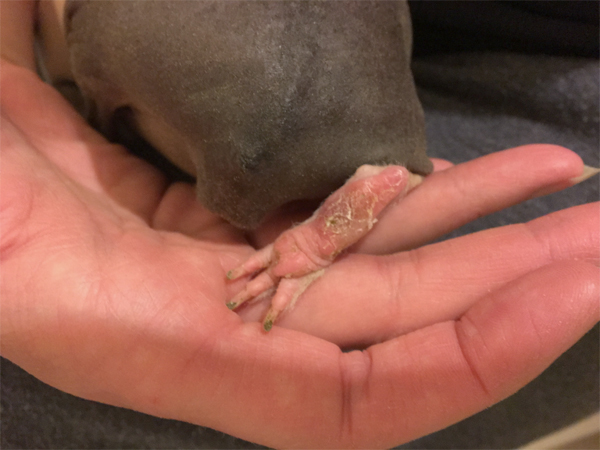
This skinny pig's foot is lightly swollen and layers of skin can be seen in distress. This is likely a very early case of bumblefoot.
Pregnancy Toxemia
Baby guinea pigs are born fully formed, with open eyes and the ability to walk right away. The large, well developed babies make birthing difficult on the mother and it is not uncommon for sows to die from pregnancy related illness. Toxemia is one of the most frequently fatal pregnancy related health concerns and should be treated extremely seriously. Symptoms include weight loss, reduced body condition, lethargy, and sunken eyes.
Death from toxemia is not restricted to guinea pigs and affects many other animals during the late stages of pregnancy. The energy requirements of pregnancy are very high and when this is combined with a drop-spike in blood sugar, the sows body may compensate by breaking down fat reserves. This emergency fat-to-energy conversion also has some serious stress effects on the liver. Feeling poorly, the sow often loses her appetite and refuses to eat. If she doesn't take in new energy to restore her depleted reserves, the cycle continues and the sow is lost.
Preemptive treatment is the best way to reduce the risk or avoid toxemia and this can be done by increasing the daily vitamin c given to the mother, as well as increasing her sugar intake as she approaches the time of her birth, and shortly following it. Vitamin c can be given through something like Oxbow's vitamin c wafers or through fruits and vegetables high in vitamin c such as bell peppers, spinach, watermelon or strawberries. Sugar can be increased by offering the sow pieces of fruit, rolled oats mixed with some molasses or by dissolving some white table-sugar into her water.
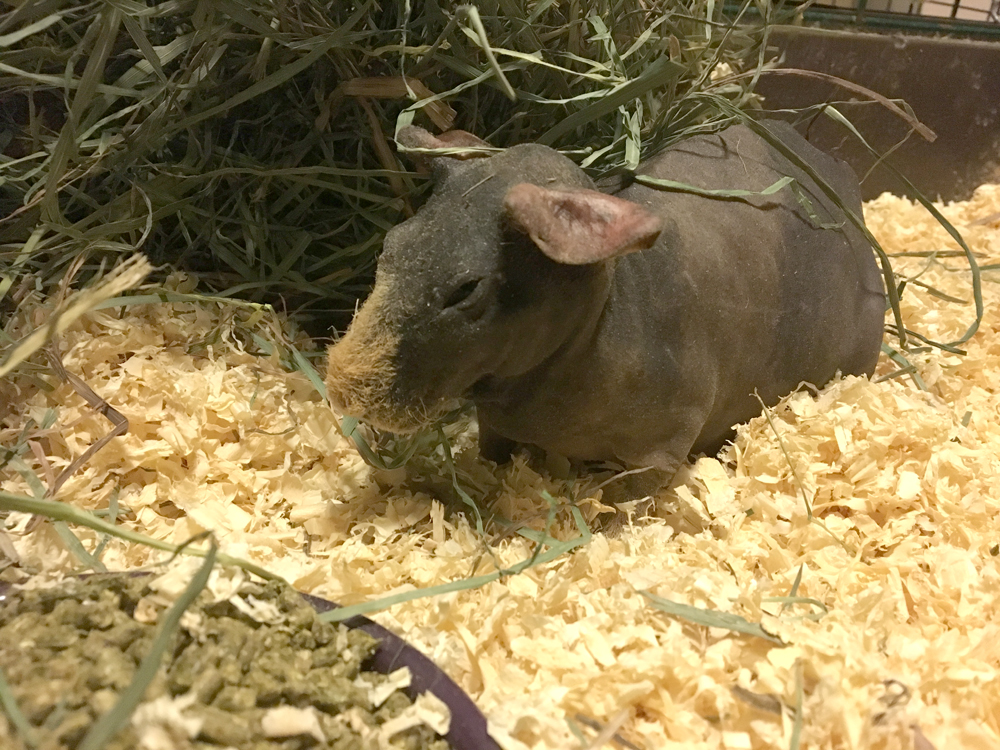
This sow's pregnancy weight makes it harder to tell she is in extreme distress but the sunken areas around her eyes and slight visibility of her spine are red flags. It turned out her four babies (still a week or two away from being ready to be born) had died in her womb and her body wasn't going into labor by itself to deliver them stillborn. Toxins built up inside her and she died within a few short hours of her condition being recognized (when this picture was taken).
Once a sow is showing signs of toxemia she is often beyond saving so pay very close attention to her behavior and activity levels shortly before, during and after she gives birth. If she shows signs of distress, is not eating, or becomes lethargic, she should be seen by an experienced cavy veterinarian immediately.
Malocclusion
At its simplest, malocclusion is misaligned and/or overgrown teeth. This is a very serious, and often mis-diagnosed condition though, as it can lead to scurvy, starvation, or death. The cause can be genetic in nature, or due to injury. Since a cavy's teeth continually grow throughout their lifetime, if the teeth do not line up properly and are not naturally worn down evenly, one or more teeth will grow too long and interfere with their ability to eat.
Common signs of malocclusion include weight loss, showing an interest in food but not eating it, picking up pellet food and having it fall out of the mouth, mouth hanging open, drooling and slowness of eating. Inspection of the incisors can be done at home, but the molars may need to be checked by a vet, as they are much harder to see.
Formal diagnosis and all treatment should be done by an experienced veterinarian and usually involves tooth filing while the guinea pig is under anesthesia. Usually guinea pigs who have overgrown teeth will need repeated filing throughout their life to ensure it does not become a problem again.
The Academy of Veterinary Dentistry can help you find a veterinarian specialized in animal dentistry to treat your guinea pig if it suffers from malocclusion.
Allergies
Just like humans, some guinea pigs suffer from allergies. They may be allergic to a certain kind of bedding or to a type of grass or hay or vegetable or leafy green. Symptoms to look for include redness or swelling, sneezing or coughing. If you have ruled out other possible health concerns and are trying to identify allergies, start by changing one thing at a time to see if the change helps your guinea pig's condition. Always remember to change bedding, food, hay or water types slowly, even when testing for allergies. You do not want to make any sudden changes as those can lead to gastrointestinal distress. If you can find what seems to be causing your guinea pig to have reactions, then you can work to replacing it with another product that is also safe and healthy.
If you are unable to identify the cause, but think it likely your cavy has allergies, you may want to take him to a veterinarian who specializes in dermatology. The website for the American College of Veterinary Dermatology can help you locate a veterinary dermatologist near you.
Scurvy
Guinea pigs and humans are very unusual in that neither can produce their own vitamin C and must get it through their diet. Like humans, if guinea pigs do not have vitamin C they will quickly develop scurvy, which is fatal if not treated/reversed.
Symptoms include physical weakness, loss of energy, loss of appetite, spots or subcutaneous bleeding under the surface of the skin, internal bleeding, weight loss, diarrhea and sudden death (if untreated).
Scurvy can be fatal to a guinea pig in only about a week's time, so it is extremely critical to always provide a proper diet to your guinea pig. Pellet food specifically designed for guinea pigs will have vitamin C already added in and should be sufficient for normal growth and maintenance, however vegetables or fruits rich in vitamin C can also be added to supplement the pellet diet. These foods include bell peppers, spinach, watermelon and strawberries. Do not give your guinea pig food designed for rabbits, rats, mice, hamsters or other small animals as it will not have vitamin C in it. When in doubt, make sure to read the ingredients of the food you are buying for your cavy.
Bacterial Skin Infection
Bacterial skin infections may occur on their own, or in conjunction with other illnesses, wounds or injuries. Symptoms may include a thick, clay-like feel to the skin, water beading up and rolling off of their skin if warm water is poured on their back, oily skin, very dry skin, twitching of the skin or excessive scratching of the skin.
Diagnosis should be made by an experienced cavy veterinarian or a veterinary dermatologist. Treatment is often in the form of medicated shampoo. In cases where a bacterial skin infection was likely brought on by a weakened immune system due to another illness or stress, the primary cause must also be treated to ensure the bacterial infection doesn't just return.
Parasites
There are several external parasites that hairless cavies are far less likely to get, including lice that are typically found living on and in guinea pig hair. But they are still susceptible to mites, fleas, and ticks. Symptoms may include excessive scratching, dry crusty or scaly areas of skin, or red spots on the skin. Diagnosis should be made by an experienced cavy veterinarian. Treatment is usually topical on the animal, and may involve cleaning or treatment of the cage, the house and/or the yard (in the case of fleas, which are not host specific).
Bloat
Guinea pigs do not have the ability to pass gas, so excessive buildup can cause bloat. Intestinal blockage can also cause this worrying condition. Symptoms include a distended or swollen looking "balloon" like belly. The guinea pig may be weak, lose appetite, stop pooping, exhibit restless behavior or heavy breathing. Young guinea pigs may be more prone to bloat and any signs of such a condition should be treated very seriously.
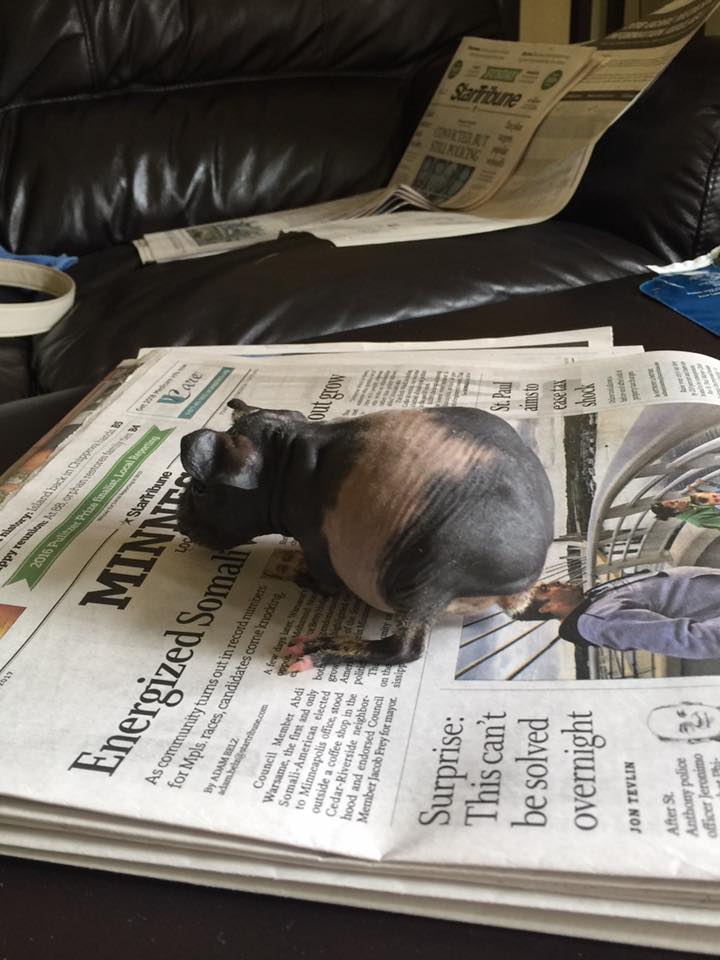
This young skinny pig may be showing early signs of bloat. Note the taut, rounded belly.
Diagnosis should be made by an experienced cavy veterinarian and treatment may include anti-gas medicine or antibiotics to try to get the intestines working properly again. If treatment is to include antibiotics, see our important notes on use of probiotcs above.
Foods that are more likely to produce excessive gas include bok choy, broccoli, cabbage, cauliflower, collard greens, peppers and radicchio. These should be avoided or fed sparingly. Lots of hay and fresh clean water can help a guinea pig recovering from bloat, or help avoid it. Water helps flush their system and high fiber foods like hay help their digestive system stay healthy.
Additional Resources
Guinea Lynx is a great website for guinea pig medical information. If our article doesn't have what you're looking for, try theirs, and of course see your cavy veterinarian if your guinea pig has injuries or is showing signs of any abnormal health.